
Nothing compares to the simple pleasure of a bike ride. J.F.Kennedy
Search this website
Buenos Aires
The ferry was departing at 09:30, so shortly after 09:00 I was already at the harbor, which was located only 200 meters from my accommodation. I had to strip my bicycle, three panniers were loaded on to the ferry as baggage, the rest I had to carry with me. The Saturday was busy and many people were traveling. The line to passport examination took about half an hour, also because, together with our ferry, a big Buquebus ferry was sailing. There were two passport controllers, sitting next to each other. One of them took care of my exit from Uruguay and the second one stamped my arrival into Argentina.
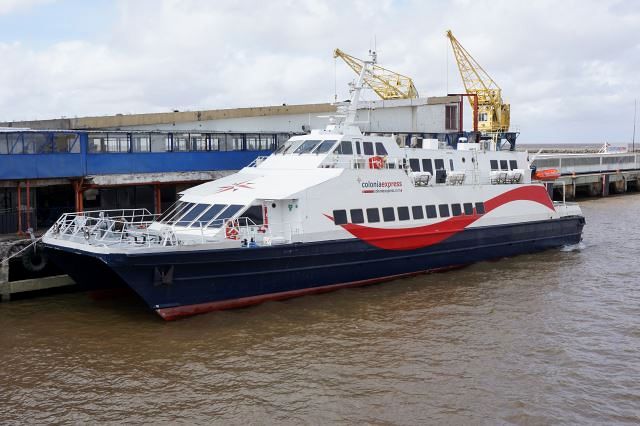
Colonia del Sacramento: Colonia Express has small boats, this is the cheapest way to get across to Buenos Aires
Our ferry owned by Colonia Express was small, only intended for passenger transport, or at the most, bicycles. The ticket was also much cheaper than those of their competitors. There was a strong wind causing big waves, the ferry was swaying a lot. Right at the beginning of the voyage, they handed out sea-sick bags. Usually I am not very resistant to sea-sickness, but that time I made it, only feeling queasy. Shortly under two hours later, we arrived in Buenos Aires. I disembarked from the ferry last, as I had to wait for my bicycle. I hung all my panniers on the bicycle, only to have to take them all off 100 meters later at the Customs control as they needed to scan them. Meanwhile, a dog trained to detect drugs sniffed everything. I was worried that they would throw away my fruit, vegetables and empanadas, which I had purchased with my last Uruguayan money. Luckily, they were not interested in those.
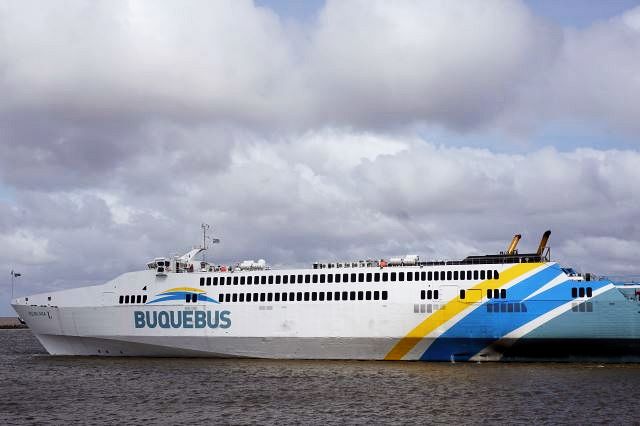
Colonia del Sacramento: Buquebus company uses bigger vessels
The reserved hostel was located about 3 km from the harbor. The GPS reliably guided me to it. Located nicely in the center, in the Montserrat district, only one block from the main Avenue 9 de Julio and only 15 minutes on foot to Plaza de Mayo square, which was considered as the city center. When I had booked the hostel at hostels.com, the displayed distance was 14 km to the center. The same figure was mentioned for other neighboring hostels. I was curious which city center they measured the distance to. I checked in and headed into the center immediately, where a Bolivian parade, reminiscent of a carnival, was taking place.
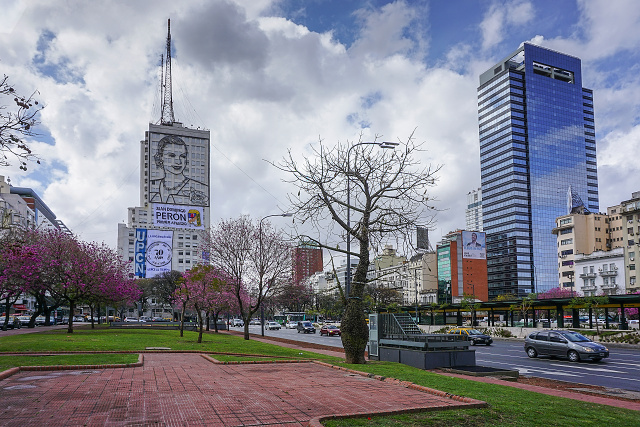
Buenos Aires: Avenida 9 de Julio - main city avenue - Evita Perón immortalized on facade of the building on the left
Bolivian Parade
When I had previously been in Bolivia, I had seen dance groups several times, but never in such numbers as in that parade. Every group had their own live band, quite a rhythmic brass band and accordingly loud. First it passed through the main avenue of the city, Avenida 9 de Julio, and at an obelisk turned into Avenida Sáenz Pena. It was surrounded by a small grandstand with free access. The grandstands for prominent politicians were at the entrance to Plaza de Mayo, where the parade ended.
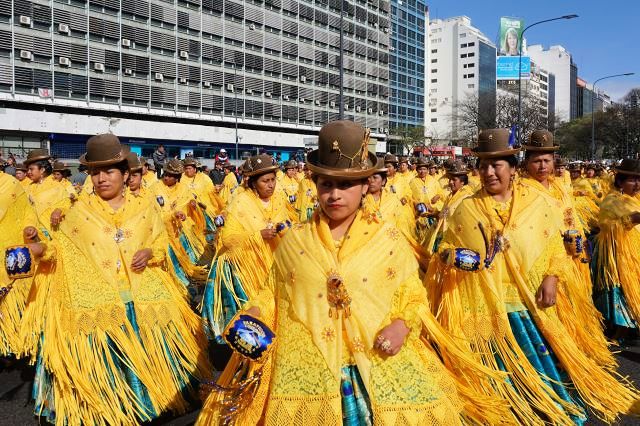
Buenos Aires: Bolivian parade - collective dances were impressive

Buenos Aires: Bolivian parade – dancers in a frenzy during wild dance

Buenos Aires: Bolivian parade – young boy hugely enjoying it
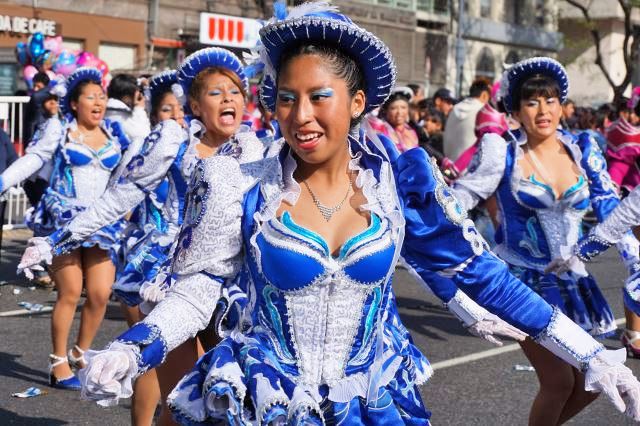
Buenos Aires: Bolivian parade - joy flowing directly from the dancers, flooding the entire street
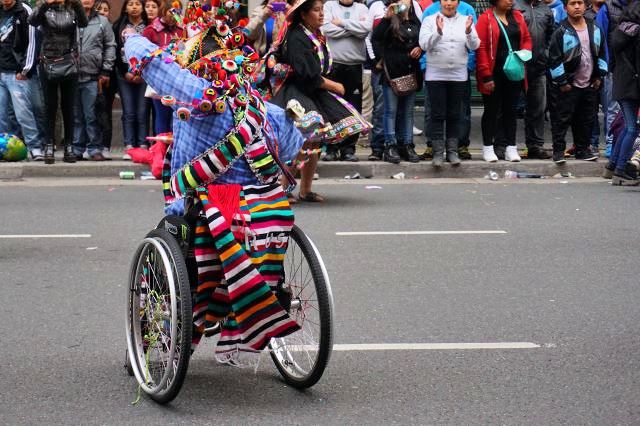
Buenos Aires: Bolivian parade – wheelchair-bound invalid dancing wildly, as if born with wheels
And there the sellers of beer and food attacked the physically exhausted, sweating and excited dancers. Several photographers were also in action there, with printers hanging on their bellies. They immediately printed the photographs and quite successfully sold them to the parade participants.
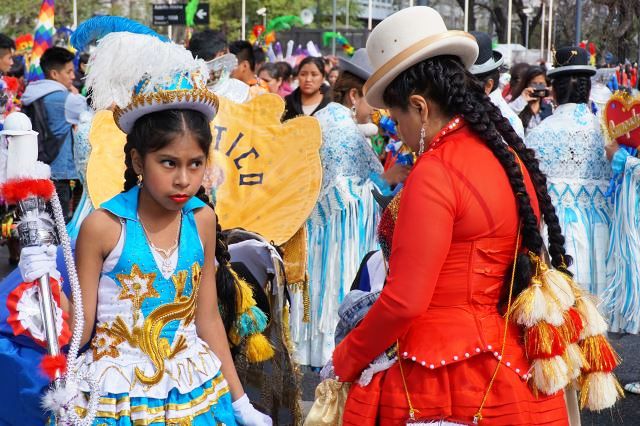
Buenos Aires: Bolivian parade – "Mom, I am the star here, right?"
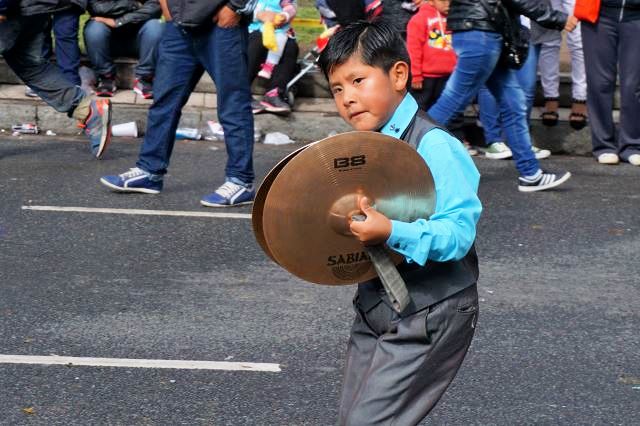
Buenos Aires: Bolivian parade – the young cymbals player was doing great

Buenos Aires: Bolivian procession - boys leading the group playing the syrinx superbly
I took many photos. There was no problem to take many photos, but it was much harder to find a place without a blocked view. I got more exhausted when sorting out the photos later, it was really hard work. I had used the photo-series function, 11 photos per second, and I took a large number of photos which differed only in minimal details, which I can hardly judge on my small display. Most photos were technically good, well exposed and focused, so I had trouble choosing the right set. Even then, I ended up with too many photos.
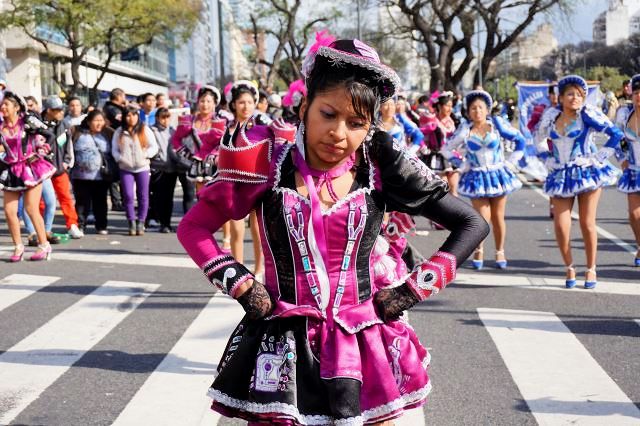
Buenos Aires: Bolivian parade - a brief stop
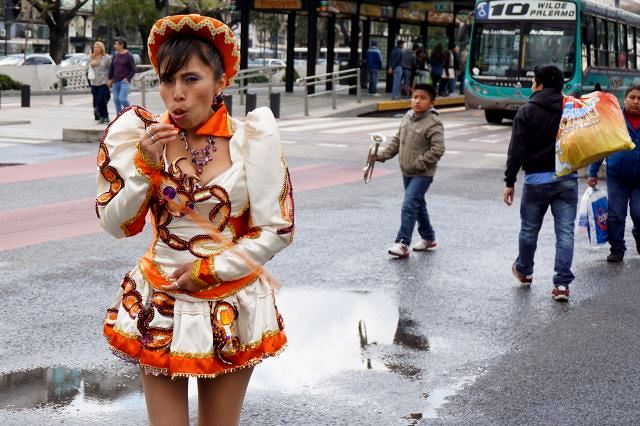
Buenos Aires: Bolivian parade - a moment of rest
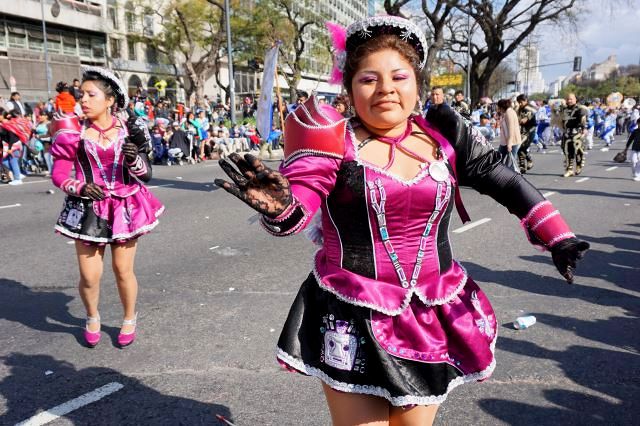
Buenos Aires: Bolivian parade - it's nice that you do not have to be young or slender to have a great time here
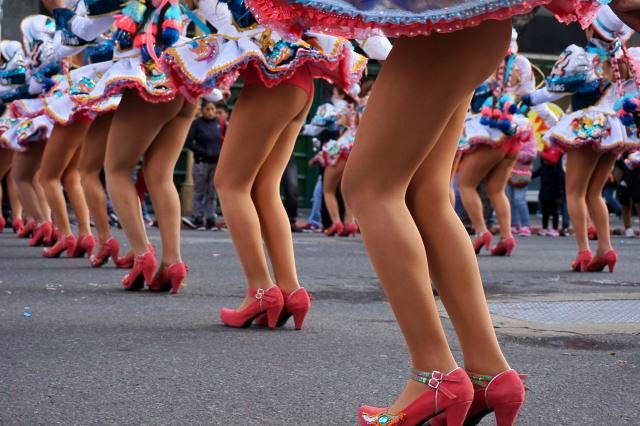
Buenos Aires: Bolivian parade - you can also see it from another angle
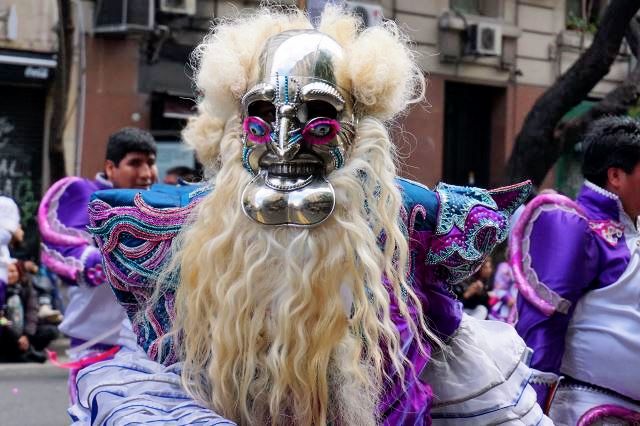
Buenos Aires: Bolivian parade - Hell, I got a fright!
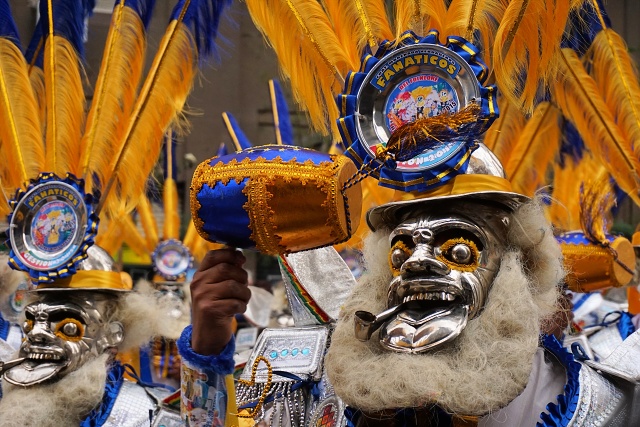
Buenos Aires: Bolivian parade – laughing masks, but underneath they must have been exhausted
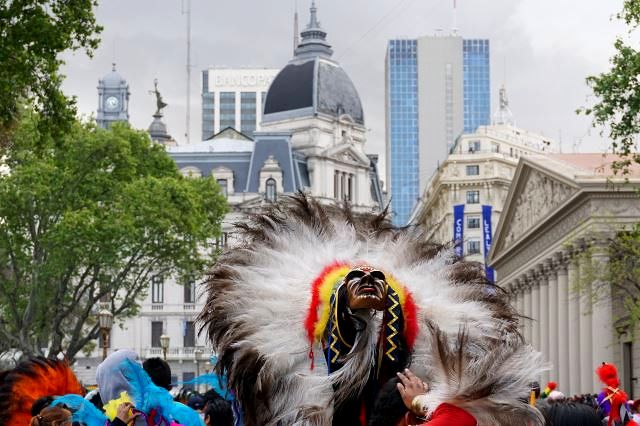
Buenos Aires: Bolivian parade - mask on Plaza de Mayo
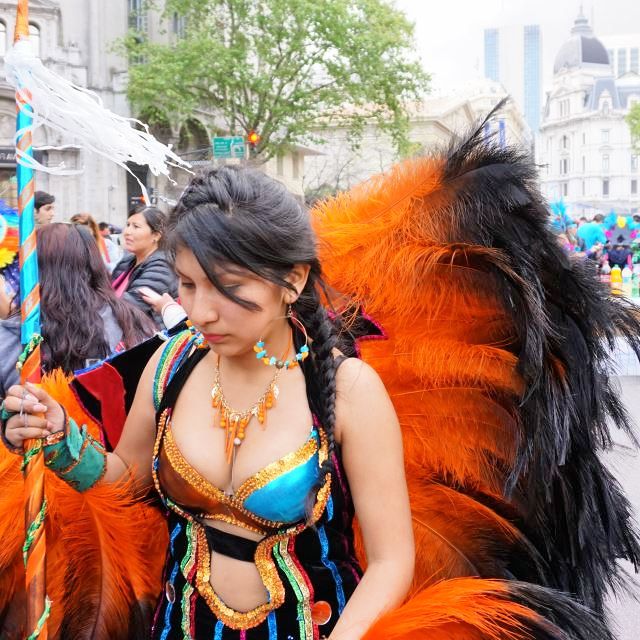
Buenos Aires: Bolivian parade – A shame it's over
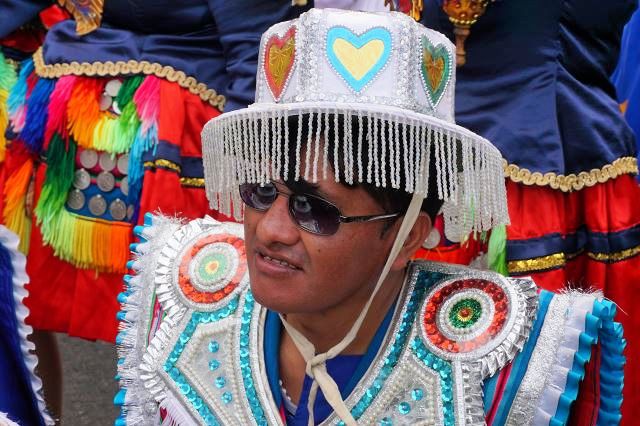
Buenos Aires: Bolivian parade - one of the participants
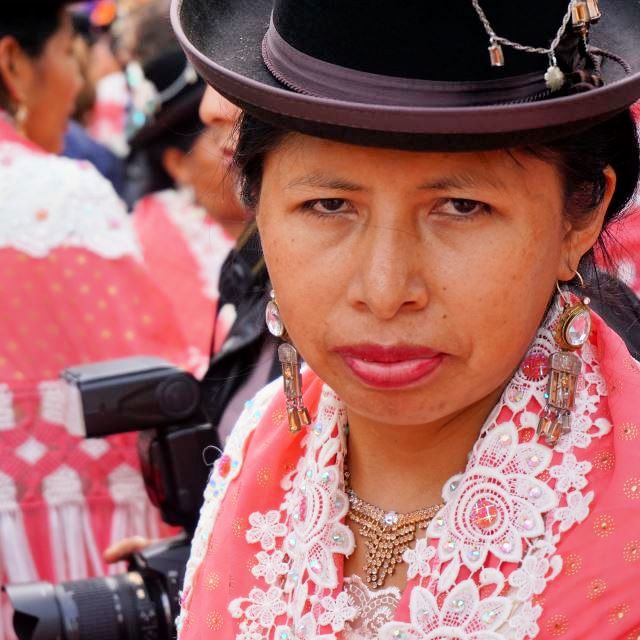
Buenos Aires: Bolivian parade - definitely not a Czech girl
The parade was fascinating, I watched it for over three hours. There were two hours left to dusk, so I headed to the park in Recoleta, 3 km away, where regular Saturday markets take place. On my way, I saw the imposing Colón Theater and exhibition buildings on Avenida Alvear. The wider area of the center is unlike the South American style and rather reminiscent of a big European city.
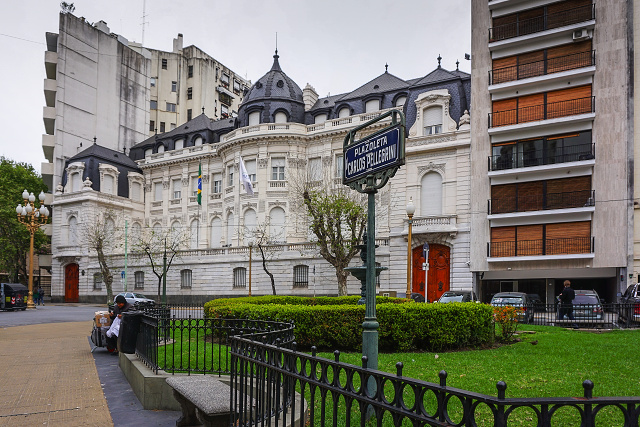
Buenos Aires: Plaza Pelegrini in one of the most expensive parts of Buenos Aires
Meanwhile the clouds started gathering. Market sellers slowly started packing up. Nevertheless, Iglésia del Pilar (Basilica of Our Lady of the Pillar) was open and I could enjoy its spectacular interior. There was another site next to it, the imposing graveyard which I left for the next day. Following the GPS, I returned to the hostel in the late evening. Even though I was not walking along the main streets, it all felt very safe, no sign of any danger.

Buenos Aires: Recoleta - a tribute to postmen
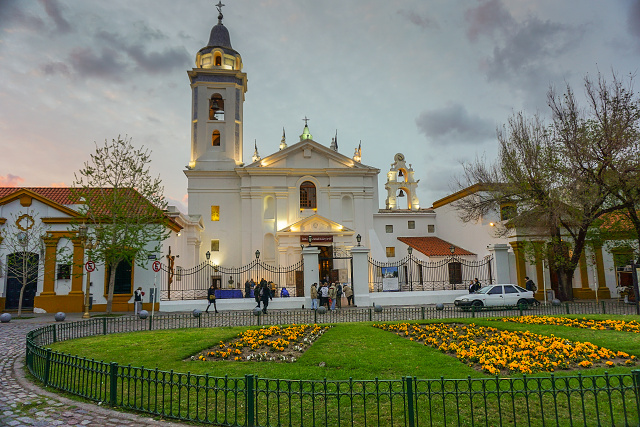
Buenos Aires: Recoleta - Iglesia del Pilar
By the way, they often warned one against the common tricks of local pickpockets. Someone might spill something on you, for example, mustard, and his friend would jump in and readily start cleaning your clothes, at the same time cleaning you out. They are very skillful and one would not even notice that they had taken your wallet or emptied your rucksack. That year, for the first time, I started using security measures – passport and one credit card and most of the cash in a waist bag under my t-shirt and only up to 200 pesos in my wallet.
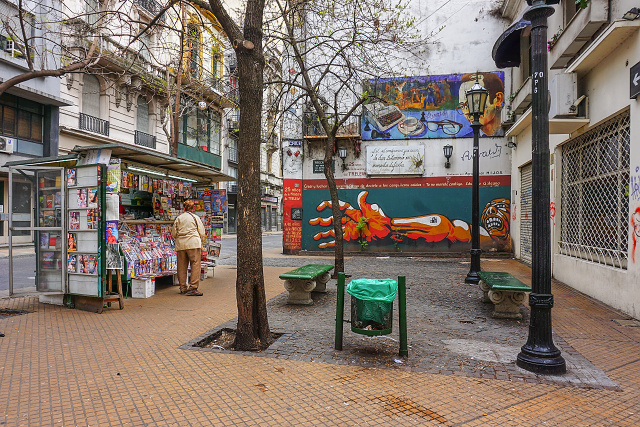
Buenos Aires: San Telmo - the city is adorned both by elaborate images…
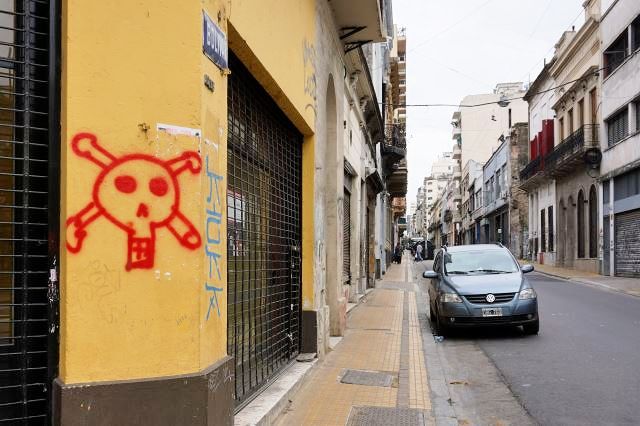
Buenos Aires: San Telmo - ... as well as by primitive scribblings
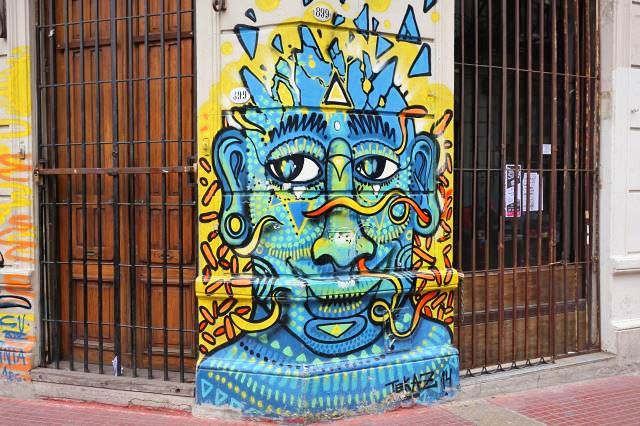
Buenos Aires: San Telmo - corner painting
BA on foot
It was recommended that I visit the flea market in Defensa Street in the San Telmo quarter. The market is huge, covering at least 10 blocks. It is closed to traffic. People sell all kinds of wares. Old tableware, clothes, useless knick-knacks, as well as obviously high quality antique pieces, souvenirs, pictures, photos, old dialing phones, archaic siphon bottles, food and beverages. A man was running around offering a Fresnel lens and shouting cinco pesos, solo cinco pesos (five pesos, only five pesos). I figured that a lens would help me to read the small text on maps. I asked him deliberately how much it cost, he said diéz (ten). I said that I did not need two, one was sufficient. We laughed, and I purchased my first practical souvenir.

Buenos Aires: San Telmo - Sunday flea market
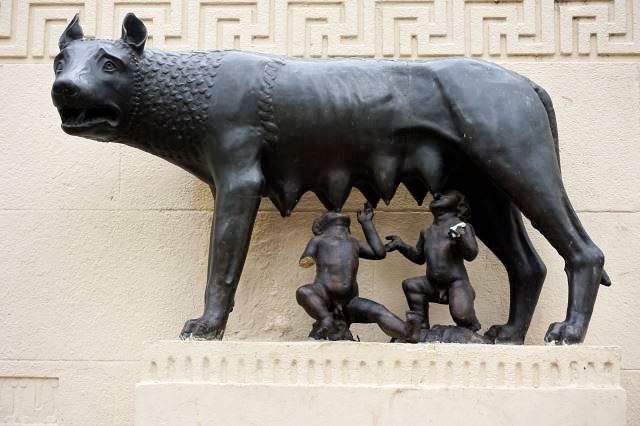
Buenos Aires: San Telmo – a legend similar to the legend of the founding of Rome
Light rain started to fall, the street performers had not yet come out, so I walked to Lezama Park, where they were also getting ready for some event. I viewed the Russian Orthodox Church only from the outside, it was closed. Another flea market in the vicinity did not interest me. Instead, I stopped at the National Historical Museum which displayed artifacts from prehistoric times all the way up to the foundation of the independent republic. The most prized showpiece was the saber of General San Martin, the greatest Argentinian hero. Next to the display of the saber, a soldier in an old-fashioned uniform stood guarding it, and in the bad lighting I could not decide if it was a figurine or a living person. He was alive. He blinked at times, but otherwise did not move at all.
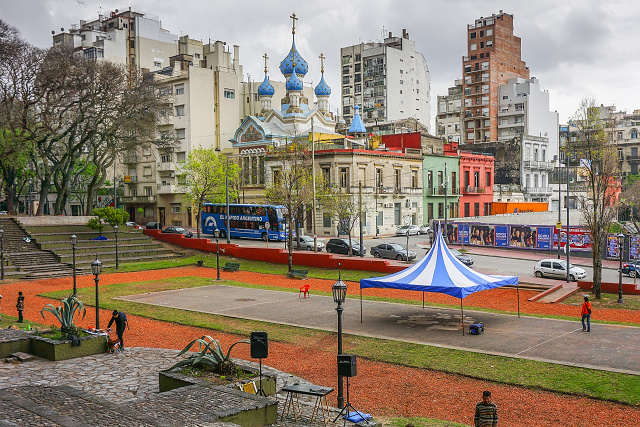
Buenos Aires: San Telmo - Lezama Park and the Russian Orthodox Church across the street
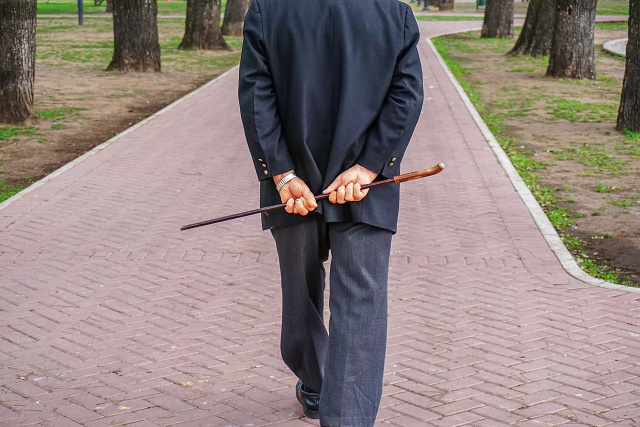
Buenos Aires: San Telmo - walk in Lezama Park

Buenos Aires: San Telmo - Museo Histórico - vista through museum gate of adjacent street

Buenos Aires: San Telmo - Museo Histórico - San Martín’s sabers with a guard of honor on watch
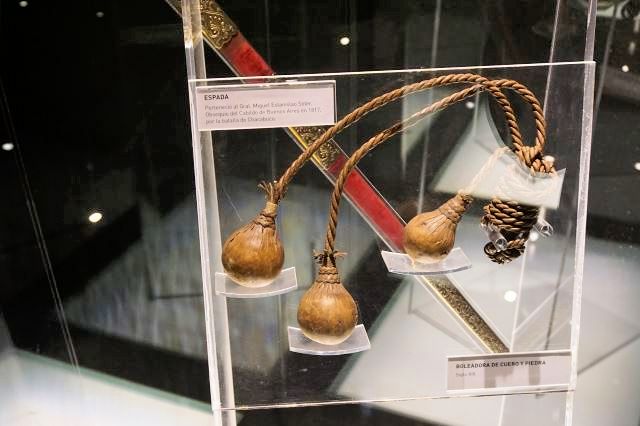
Buenos Aires: San Telmo - Museo Histórico - bolaso
I returned to Plaza Dorrego, viewed the Cathedral in the vicinity of the local market. Then I slowly strolled to Plaza de Mayo. Balcarce Street was decorated by pop art figurines, which made my walk more enjoyable.
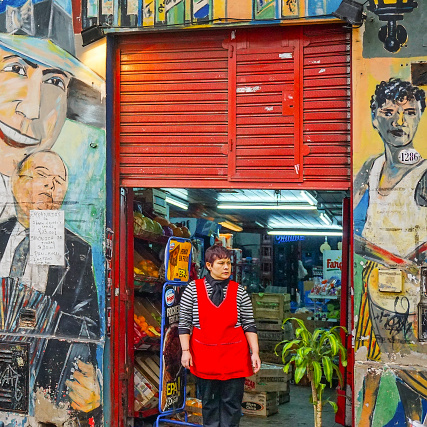
Buenos Aires: San Telmo - merchant looking out for customers
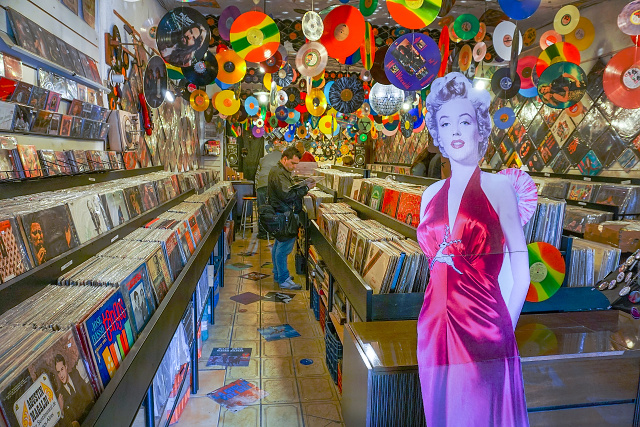
Buenos Aires: San Telmo - LP store

Buenos Aires: San Telmo - street mannequin
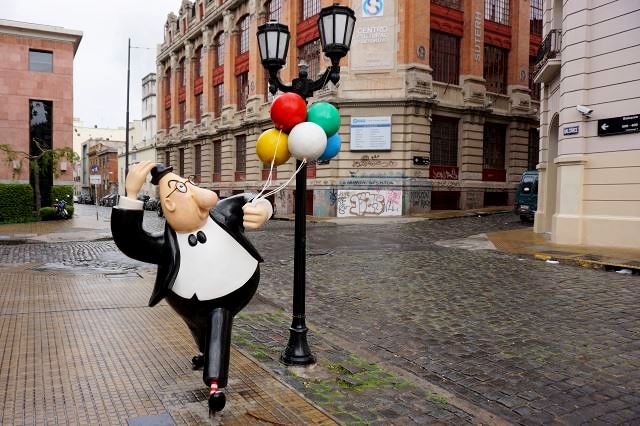
Buenos Aires: San Telmo - street mannequin
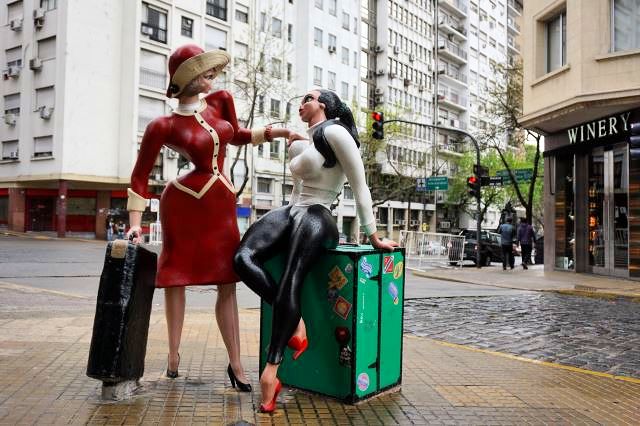
Buenos Aires: San Telmo - street mannequin
An impressive Baroque Metropolitan Cathedral is located on the square. The rather small building from the outside is not noticeable in the vicinity of the tall buildings neighboring it, yet the interior is beautiful and amazing. The tomb of San Martin, once again guarded by two motionless soldiers, is in one of the side chapels.
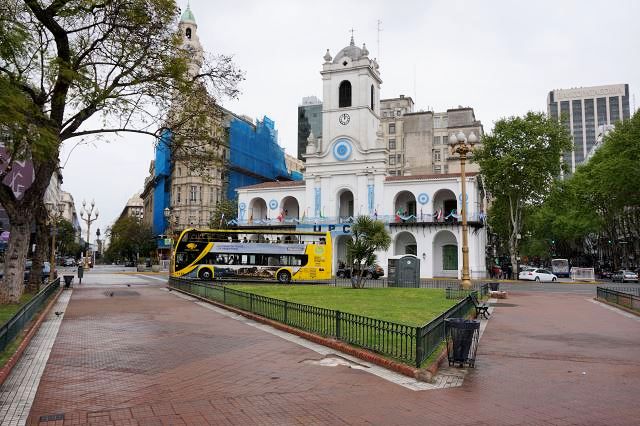
Buenos Aires: Centro - Plaza de Mayo
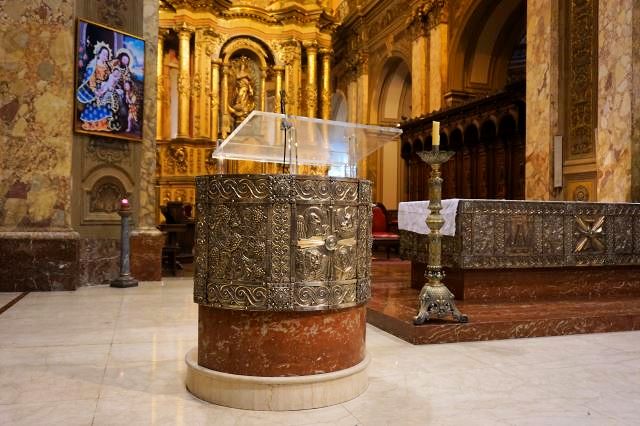
Buenos Aires: Centro - Plaza de Mayo - in the Metropolitan Cathedral
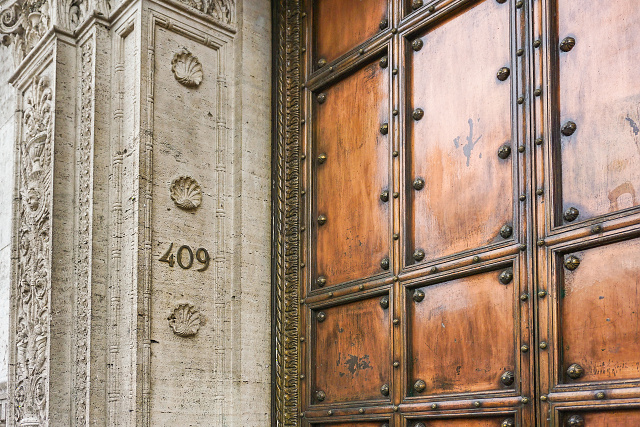
Buenos Aires: Centro - Plaza de Mayo - doors
The governmental Pink House (Casa Rosada) completes the square. I went through a security control of the same level as at airports and entered an open area. I lined up for a free tour, where they handed out various colored tokens. Together with my neighbors in the line, I received a yellow one, which meant that our tour would start in 2.5 hours. I considered it for a while, but then handed my token to a boy in the line and left. Even though I liked it there very much, I went to see the attractive inner atria and picture gallery including all the significant people in South America. Not to worry. Evita Peron was naturally included, as well as Che Guevara and the Chilean President Salvator Allende. I only could not find General Pinochet.

Buenos Aires: Centro - Plaza de Mayo - Pink House – painting of Bolivar
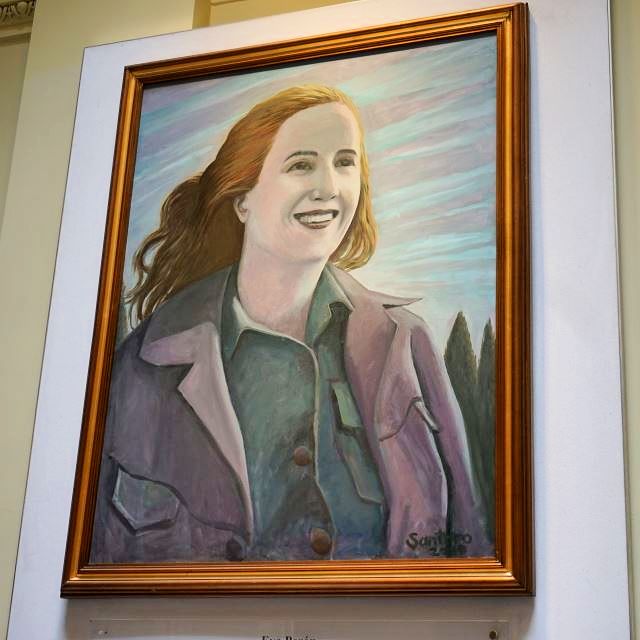
Buenos Aires: Centro - Plaza de Mayo - Pink House – Evita can not be absent from the picture gallery
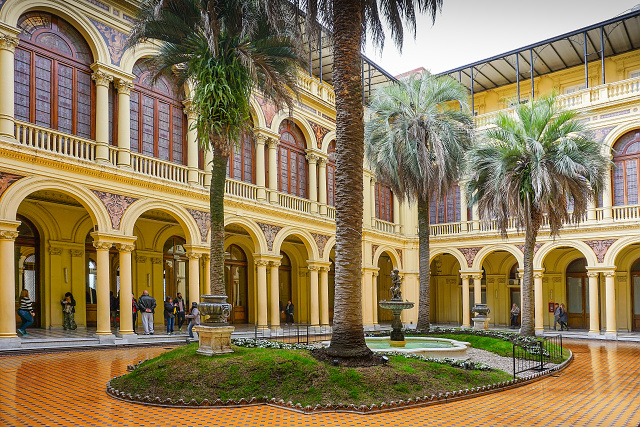
Buenos Aires: Centro - Plaza de Mayo - Pink House - courtyard
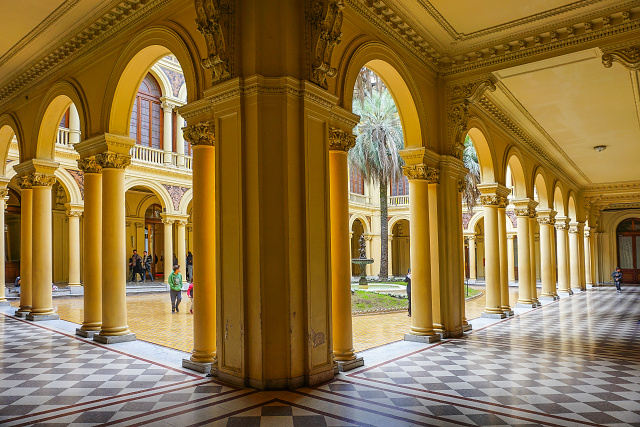
Buenos Aires: Centro - Plaza de Mayo - Pink House - courtyard
I was well warmed up by the walk, so continued along Florida Street, a shopping area filled with vendors who shouted at every potential buyer "gambio, gambio" (change, change). I wondered how so many people could make a living like that. I reached Plaza San Martin and arrived at Ricoleta via Libertador Avenue.
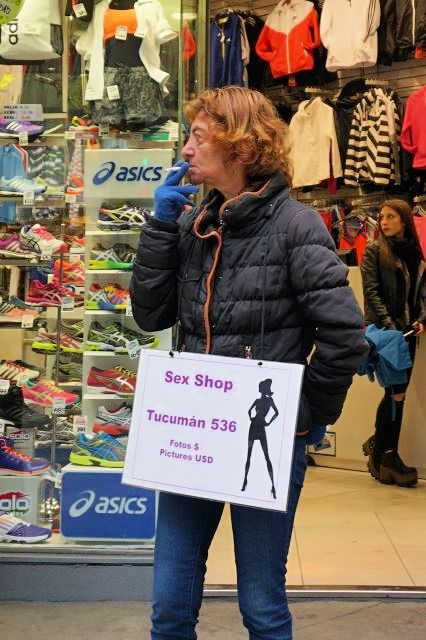
Buenos Aires: Centro - Callé Florida - lady promoting a sex shop, clearly with extensive experience in the field, apparently starting from scratch
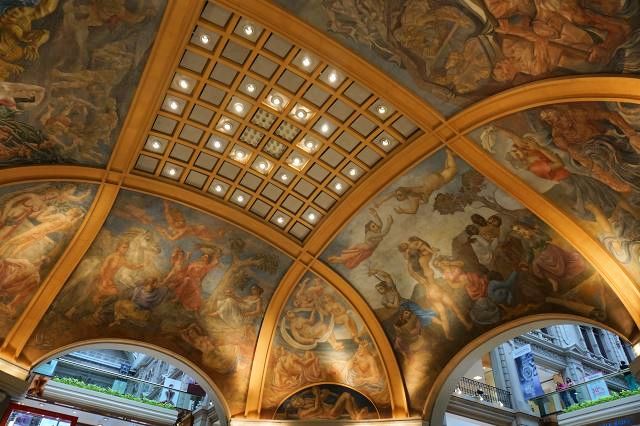
Buenos Aires: Centro - Pacific Mall store
This time, I visited the famous graveyard. An old man was sitting at the main road. When someone got near to him, he would shout without hesitation "al frente, al frente" and point in front of him. What was he pointing at? Naturally, at the way to Evita Peron, whose remains are deposited in the grave of the Durante family. It is located in a narrow alley, with so little space that I had to photograph it with the panoramic function, because my lens starts at 25 mm.
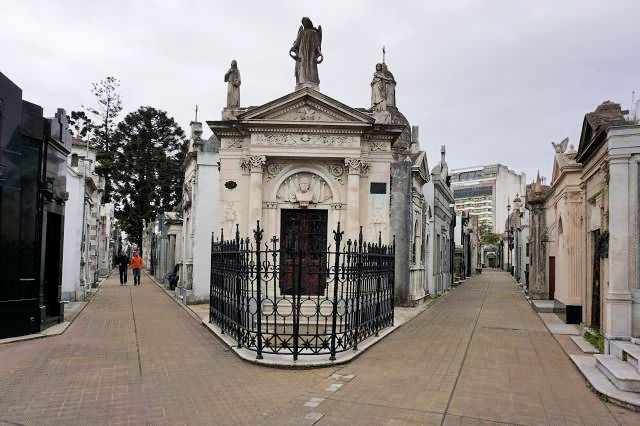
Buenos Aires: Recoleto - cemetery
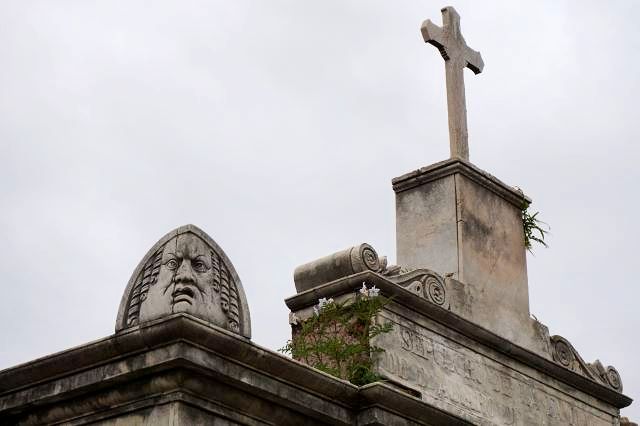
Buenos Aires: Recoleto - cemetery - tomb detail
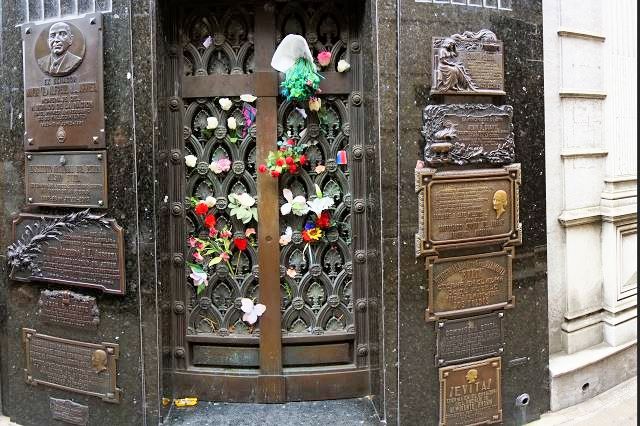
Buenos Aires: Recoleto - cemetery - Durante family tomb, where Evita is buried
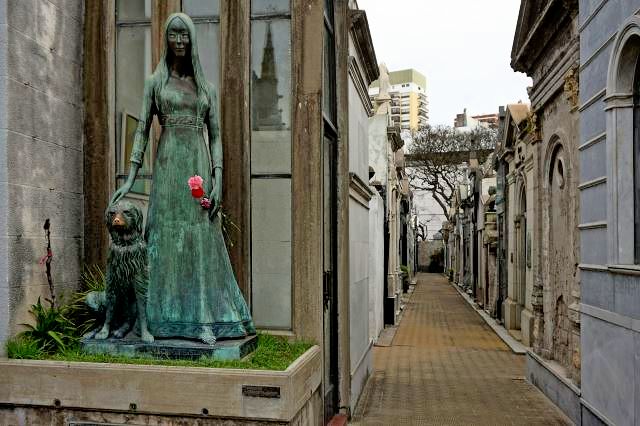
Buenos Aires: Recoleto - cemetery - tomb
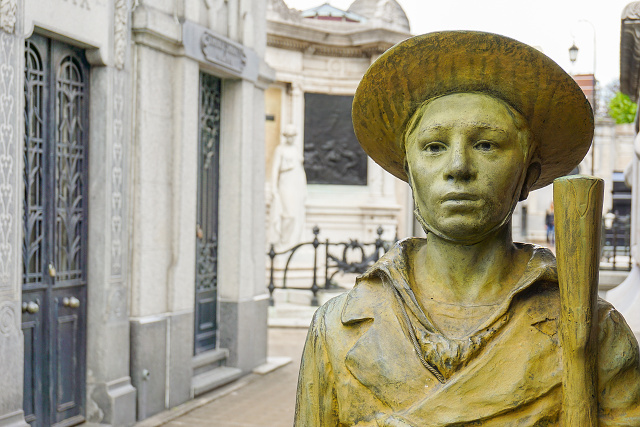
Buenos Aires: Recoleta - tomb of Paraguayan soldiers
BA on bicycle
I had walked more than 20 km, yet I had visited only the nearest vicinity of the center. The following day, I took my bicycle. It was a bank holiday, but in the hostel they did not know what the reason was for it. Traffic was minimal. First I went to Boca. Tourists usually did not venture further than Caminito, which was a typical "tourist village" with well-maintained metal plate-covered houses, in saturated colors, leftovers from when seamen painted their boats. Originally this quarter suffered frequent flooding from the nearby river venting into the Río del Plata River, so they rather built cheap houses to prevent huge damage. The flood risk ceased several years ago and the houses have become a tourist attraction.
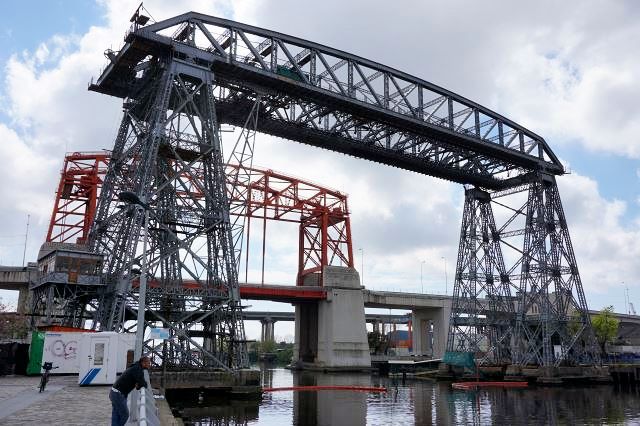
Buenos Aires: Boca - bridge structures typical of this district

Buenos Aires: Boca - elaborate murals are present everywhere
I dared to enter the outside borders of the quarter by bike, knowing I could quickly ride away should I get into any trouble. Luckily nothing bad happened, not even a bad look at me. Caminito was funny, many painted walls, a naively expressed wide spectrum of statues on a balcony, from loose women, Maradona the football player, to the current Pope Francis. And of course there were pubs, stores selling souvenirs and various knick-knacks.
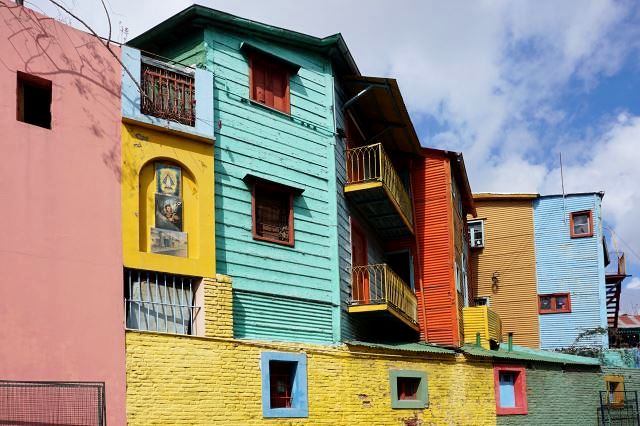
Buenos Aires: Boca - colored houses
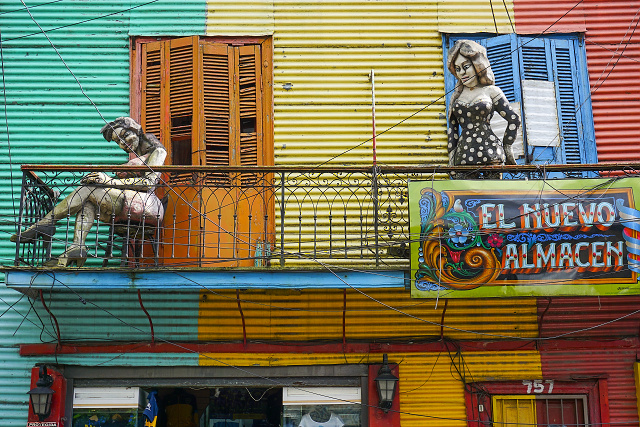
Buenos Aires: Boca - figurines on balcony

Buenos Aires: Boca – store
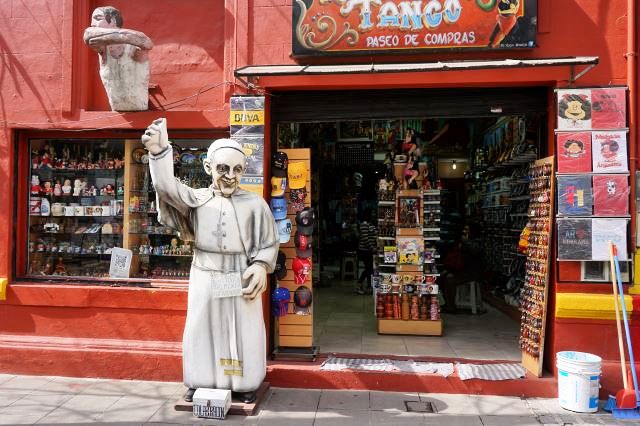
Buenos Aires: Boca - Pope as figurine outside a store

Buenos Aires: Boca - detail of mural
Using the cycle path, I cycled from Boca to Puerto Madero. Originally the home of an old harbor, this has become an elegant, newly built quarter with tall buildings and restaurants beside the canal. Two-hundred-year-old ships were anchored in the water, a combination of steamships and sailing boats. To maintain the atmosphere, the harbor cranes have been preserved, providing the quarter with the right atmosphere.
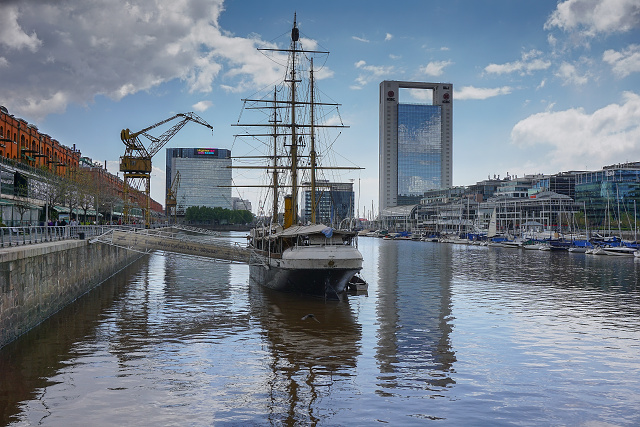
Buenos Aires: Puerto Madero - new harbor construction
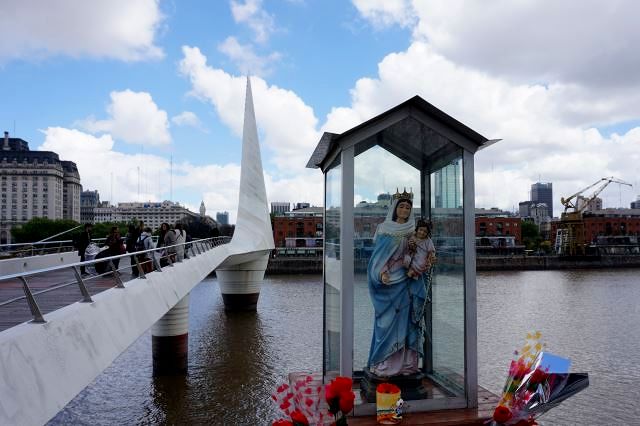
Buenos Aires: Puerto Madero - Madonna at pedestrian bridge
I only had to transfer myself less than one kilometer to enter Costanera Sur Ecological Reserve. The original swamplands around Rio del Plata have remained untouched and it is possible to visit them on foot or by bike on unpaved roads. The cycling speed is limited to 10 kph. It was a pleasant change from the hectic metropolitan city. For a while, I sat on the river bank. The river is the color of white coffee due to the excess of iron in the ground.
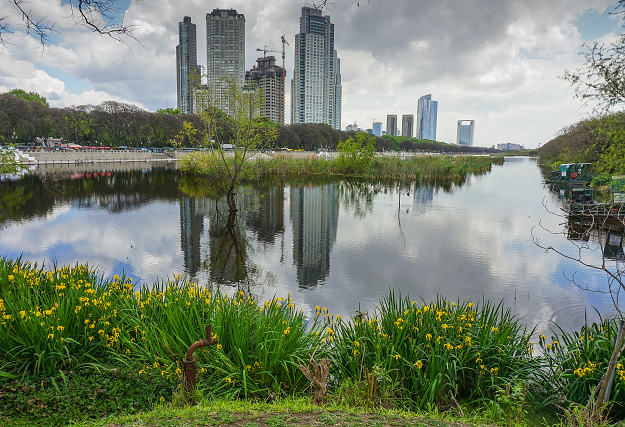
Buenos Aires: Puerto Madero - ecological reserve
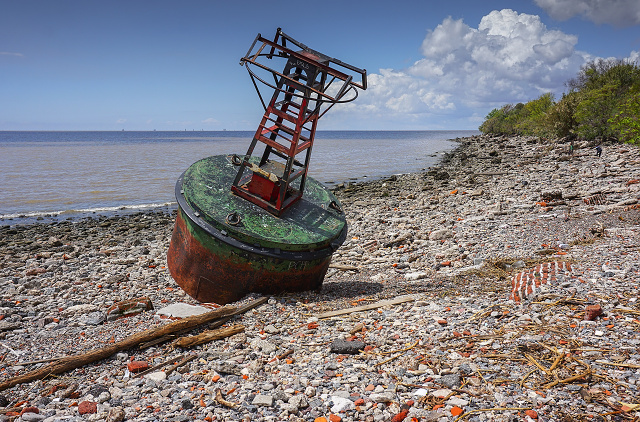
Buenos Aires: Puerto Madero - ecological reserve - Plata riverbank
Then for a while I left the cycle path, as I spotted a flea market at Retiro station. The goods offered clearly revealed that the market was not focused on tourists. There was no tourist in sight either. I cycled through it and it constantly drew me towards a part with poor houses, crammed into narrow, dark streets. Mud everywhere and pools of water, stray dogs and kids happily playing in the dirt. I did not want to turn around, so I did a 3-km long trip through it. Once I dared to take out my camera, but the locals did not seem happy about it. I was happy when I left to cycle back on to a normal paved street.
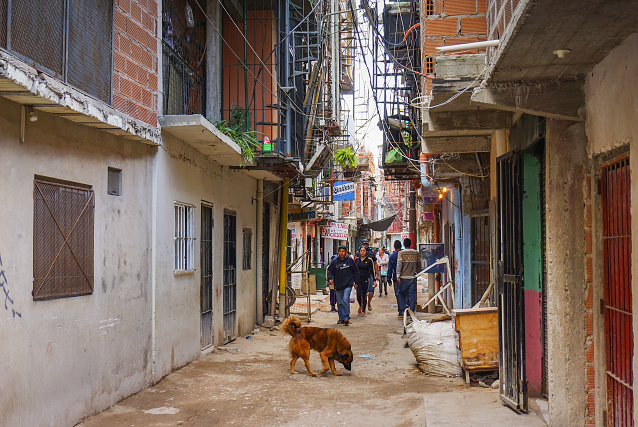
Buenos Aires: Retiro - poor neighborhood where I unwittingly found myself
I returned to the cycle path and continued to the famous parks in the Palermo Quarter. Pleasant cycling, except the many people everywhere and the cycle paths were usually quite narrow. As they were marked out on an existing street, they were usually only one meter wide and, on top of that, divided by a line in two directions. But it was manageable. When the cycle path was marked on a pedestrian pathway, it was generally wider. Nevertheless, the pedestrians do not respect it anyway and, for example, four friends walking next to each other easily block it. Another enemy of cyclists as well as pedestrians are the turning cars. Although both receive the green light at traffic lights, the turning cars do not give a damn. They do not wait for the pedestrian crossing to empty, so one has no choice but to insist on the green and hope that the cars manage to brake in time.
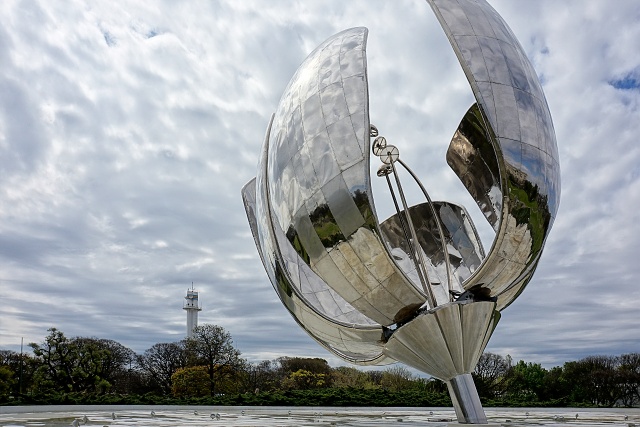
Buenos Aires: Recoleta - Floralis Generalis - mechanical flower sculpture
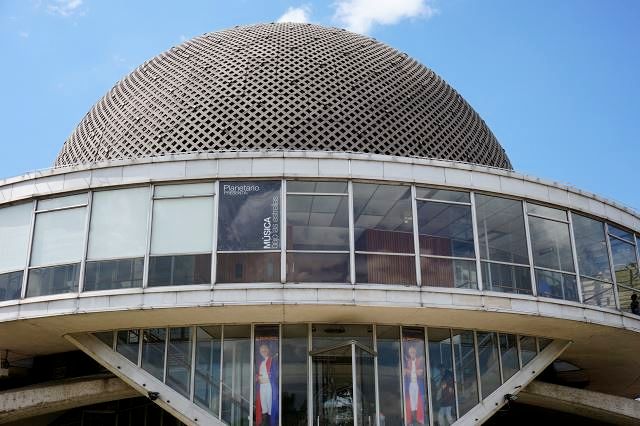
Buenos Aires: Palermo - planetarium
Even then I enjoyed those 50 km or more around the city. In the evening, I headed for the center. I dined well in a restaurant selling food by weight. The usual price was 70-80 peso per kilo, so one could eat really well for about 40 peso (CZK 100, $5).
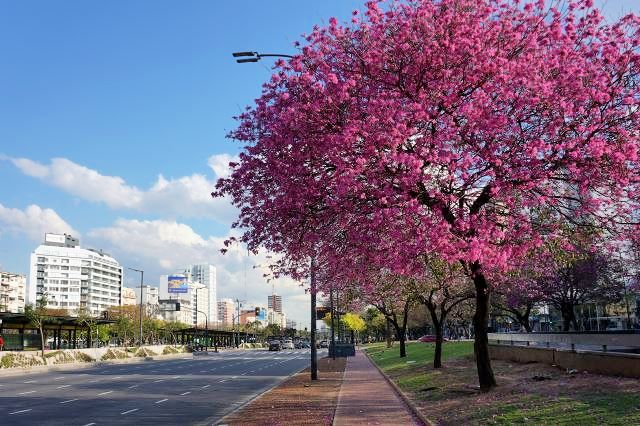
Buenos Aires: Centro – Spring in Avenue 9 de Julio
Tengo Tango
"I have Tango" I said to myself on Dorrego Square. Every evening there was a dancing couple, cashing in after their show. I was still to take some Tango photos, so I was happy to fulfil that wish.

Buenos Aires: San Telmo - Tango on Plaza Dorrego
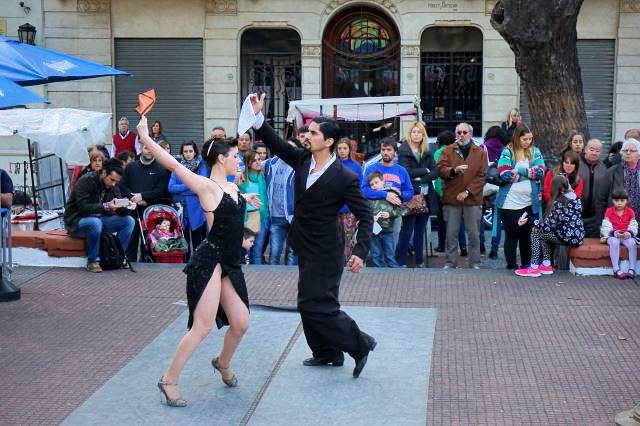
Buenos Aires: San Telmo - Tango on Plaza Dorrego
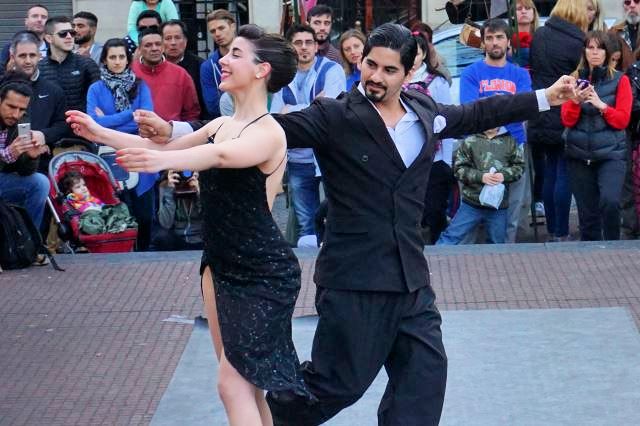
Buenos Aires: San Telmo - Tango on Plaza Dorrego
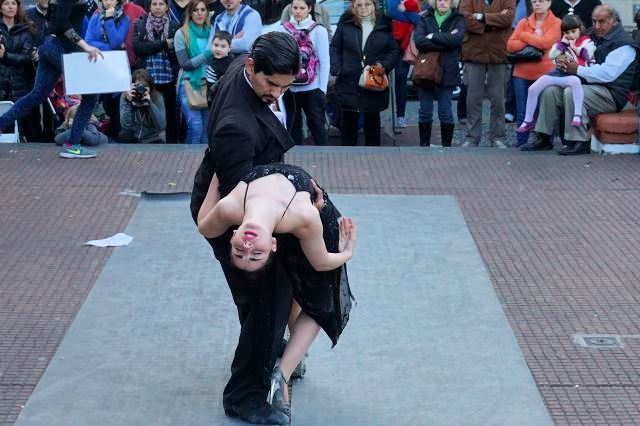
Buenos Aires: San Telmo - Tango on Plaza Dorrego
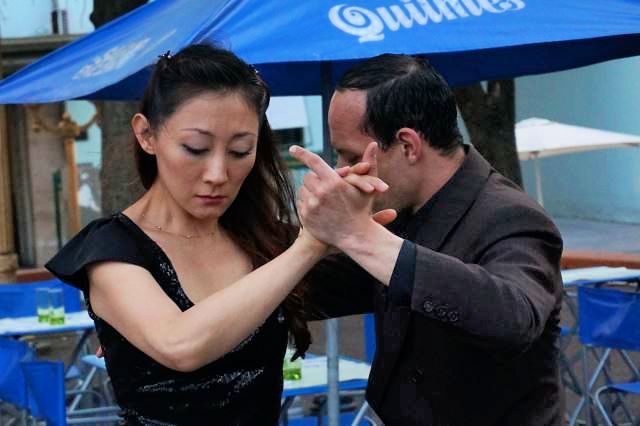
Buenos Aires: San Telmo – street Tango
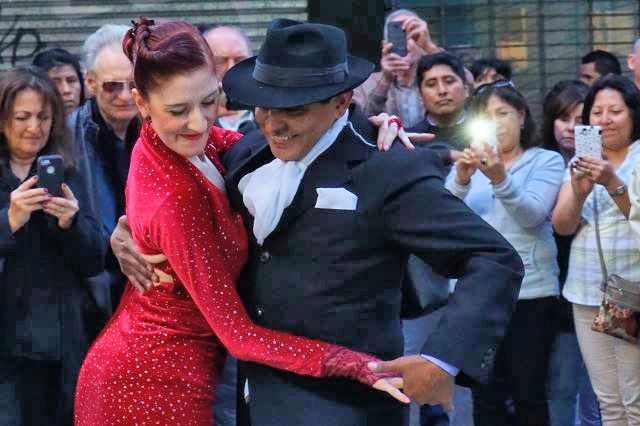
Buenos Aires: Centro – tango on Florida Street
I stopped at a metal band on my way home. They were banging instruments on 9 de Julio. They were shouting some revolutionary lyrics, dancing pogo and it seemed as if a fight was about to break out. Looking different, I stuck out, and they greeted me and forced me to drink some liquid which they were readily pouring down their throats. I refused, but otherwise we were friends. Finally, it turned out well. A group of people who had been partying at the hostel for two days and two nights under my windows, and whom I'd had to ask to calm down at 03:00 as they were shouting loudly while smoking in the yard, had finally left. It was a quiet night and after the bike ride, I slept beautifully.
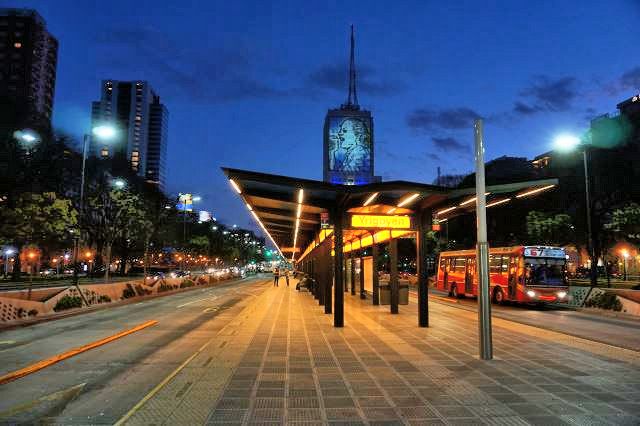
Buenos Aires: Centro - night in Avenue 9 de Julio
The last two days I dedicated to the purchase of equipment. It was rather exhausting to locate a gas canister for my stove. I finally found one in Paraná Street where there were stores selling fishing gear and weapons. I succeeded at the third try. The price was almost half of that in Posadas.
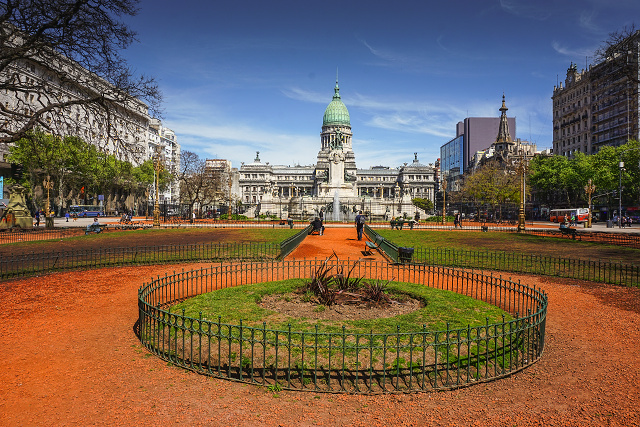
Buenos Aires: Centro - National Congress
My cycling sandals were reaching the end of their life. They had cycled a respectable 20 000 km. Keen no longer produced them, so I could not get the same ones. The straps through which the shoelaces go started to break. I fixed them with elastic bands, my universal tool. Nevertheless, I wanted to get new ones, so I walked around all the significant cycle stores. No luck.
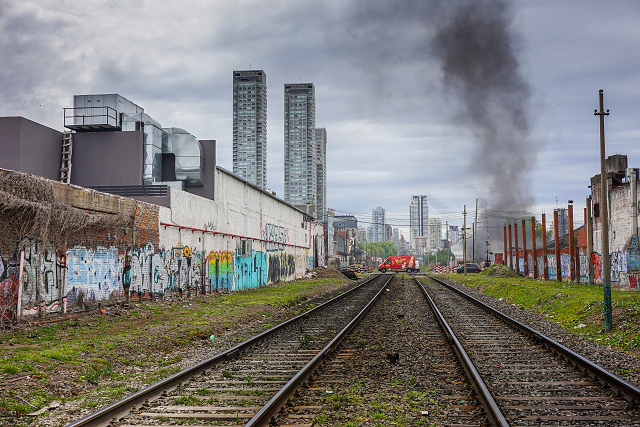
Buenos Aires: Palermo - railway line
Museums
I purchased a road map and decided on my next route. I dedicated the last day to art museums. Not so good. MALBA, a museum of Latin-American artists, was quite a nice, modern building, very light, similar concept to the National Gallery in Trade Fair Palace in Prague.
They displayed several pieces by my new favorite artist, Uruguayan Joaquín Torres García. Unfortunately not from the period which I liked so much. Several interesting Realists, large canvases with social themes. Then several modern pieces, all in all about nothing. For example, they let one or two people enter a dark room, then lit a panel with colored lights and then turned it off. A better idea was the "wind show" (the real name was something else). People walked in total darkness through a narrow corridor and the wind blew at them from different directions and intensity. I cannot complain much. As a senior citizen, I had free entry. Other people paid half price, a discount available every Wednesday.
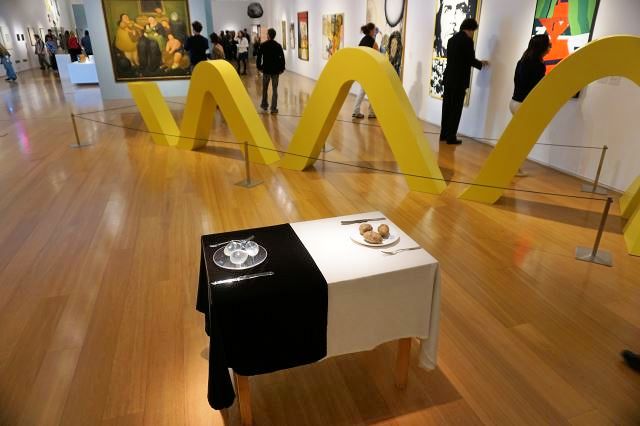
Buenos Aires: Palermo - exhibition in MALBA
On the way to the National Museum of Fine Arts, I visited a university located in an enormous, stylistically clean, classicist building. From its sign I understood it was the Faculty of Law and Social Sciences. The hall was impressive, as you can see in the photo.
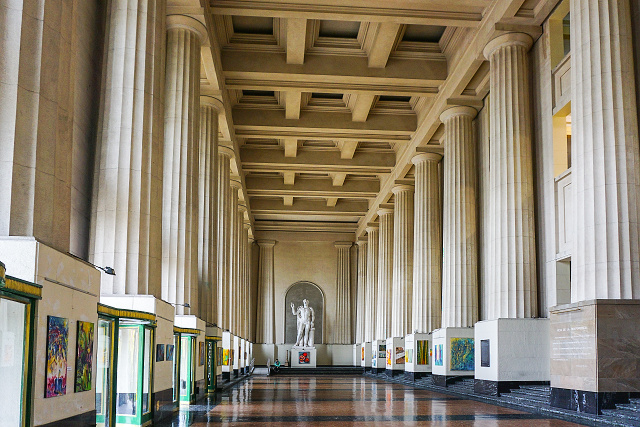
Buenos Aires: Recoleta - University hall
There was almost nothing I liked in the National Museum of Fine Arts. The collections were placed in dim light, so that even young people (not only I with my worn-out vision) had problems reading the labels of the paintings. To make it even more difficult, a line was painted about half a meter from the wall and the guards rigorously admonished anyone who crossed it. People were bending towards the wall, balancing on their toes to check that they were not stepping over it.

Buenos Aires: Recoleta - National Museum of Art
They displayed several European paintings bearing the names of famous artists — Van Gogh, Modigliani, Renoir and others. There was even a solo Monet exhibition – four paintings in a specially reserved room. This contrasted sharply with the Latin-American art, where 100 paintings were hung in one room – in several rows above each other. I do not want to comment on the current Argentinian works. They meant nothing to me. It could be because I was tired, I had walked at least 30 km that day.
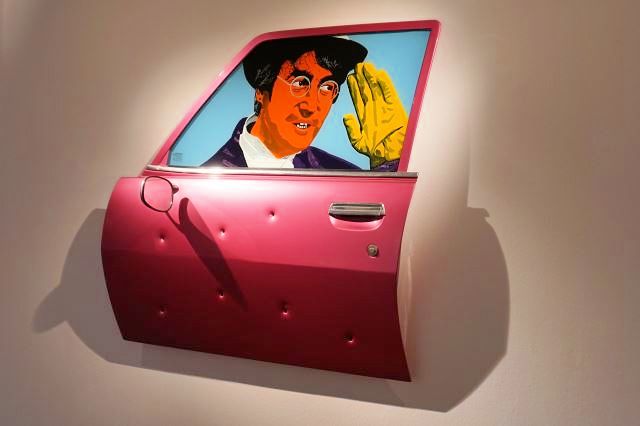
Buenos Aires: Recoleta - National Museum of Art - Contemporary Argentinian trends

